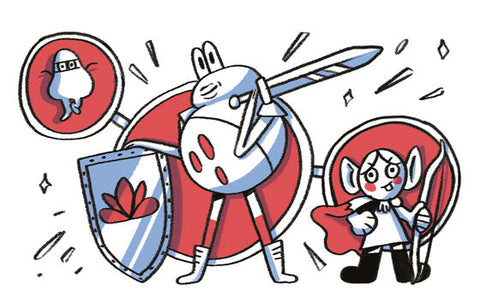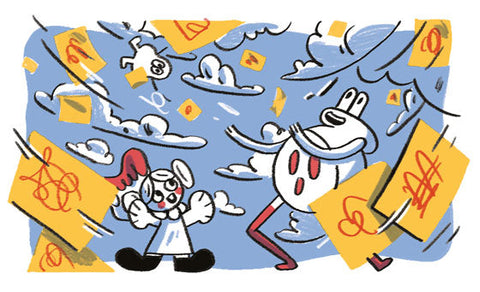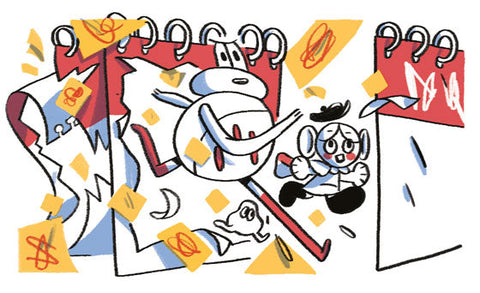ℹ️ Skip to key parts of the session by clicking on the chapter dots along the timeline.
During this session, Simon White talks us through how we can bring play into workshops using 3 fun and simple techniques.
If you’re following along at home, you will need a pen and paper (with 6 drawn boxes).
👉 View the Miro board for this session
Why use playful techniques in workshops?
- Forms collaboration
- Helps demonstrate different aspects of your strategy
- Can be used with multiple people including those at board level
- Shows the difference between ‘agile’ and ‘waterfall’ and why it’s important
- In a stakeholder group, it works out which people need a lot of detail versus those who only need to see the initial framework
- Can sometimes be a way to create marketing ideas or narrative when you’re thinking about selling a new product
- Generates new ideas in a fun way without doing a brainstorm (aka. Monkey Tennis)
What are the three techniques used in this session?
- 6 Boxes, 1 House
- 1, 2, 4, All
- Yes, and…
Who would these techniques be suitable for?
- Boards of international companies
- Marketing departments
- Schools – including pupils and teachers
- Groups of engineers
- Local / national / international businesses
- Internal product teams
- Corporates and creatives
- And anyone else you can think of!
Technique #1
The 6 Boxes, 1 House Exercise
This exercise has been inspired by Carlo Brunetti, a cartoonist and cartoon lecturer from New York. Carlo’s technique has been adapted to be used as a way of assessing how much detail you need to put into a project or prototype.
The technique can be used to understand iteration and/or MVP to a group of people that don’t completely understand it.
This technique is great for getting an insight into who from, your stakeholder group, requires the maximum amount of detail compared to those who are happy with a basic prototype.
It’s the conversations at the end of the drawing exercise that makes this technique so valuable.
How to run the technique
Hint: before starting, ensure everyone has their 6 boxes already drawn out.
Step 1
Give your participants exactly 1 minute to draw a house in box number 1. Prompt your participants to draw their house for the entire duration of the minute.
Step 2
Now ask your participants to draw the exact same house in box number 2. But, this time, only give them 30 seconds to draw.
Step 3
Repeat the process for step 3, asking your participants to draw their house again but in a 20/15 second time frame.
Step 4
Repeat the exercise for 10 seconds.
Step 5
Repeat the exercise for 5 seconds
Step 6
In the last box, repeat the exercise but with only 3 seconds.
Step 7
Now ask your participants to put an asterisk/mark by the drawing they think still best depicts a house and one they’d be happy to show someone who would also identify the drawing as being a house.
Why this exercise is a powerful tool
Compare this exercise with a typical project. Projects often over-run because people think they want what is in box number 1 - a detailed house with all the extras. By doing this exercise, you'll start to ask yourself what do you actually need for your project – e.g. do you really need smoke coming out the chimney or the trees? Usually what people actually need is the house that’s drawn in box number 3 – the house that you can still clearly see is a house but without all of the extra bits. That is your prototype. Not the all-signing-all-dancing product you thought you needed but the option that includes the aspects that you ACTUALLY need.
It’s not bad to want what is in box number 1. Choosing box number 1 only emphasises what that person expects to see at the end of the project. If they expect what's in number 1 and you present them with a product that resembles box number 6 then it wouldn’t go well!
When is the best time to run this exercise during a workshop?
Use this activity near the beginning. Not necessarily the first exercise but near the start always works well.
Step 8
Ask your participants their thoughts on this exercise.
What have you learned from the exercise? Can you apply what you have learned to a project or prototype that you are currently working on?
- If there is a tight deadline, the last house is a clear example of why working quickly wouldn’t produce a product worth showing
- Adds to the ‘less is more’ approach - the less detail around the extra components means there will be more focus on the main part of the project
- Important vs. urgent: if you’re short on time, you’d still draw the house because that’s the important part rather than the additional features
- In some scenarios, you might be designing your customer's first house or a migration project: the house they currently have may not look like the house they are trying to move in to
- In some cases, you might find that the house was never the focus and the setting in which the house sits is more important
- When you start to dissect the drawings you will start asking; what is our roof, what is our single window, what is our front door, what features have been left out of the drawings? The language of this exercise can affect the culture of the team and facilitate shared understanding. You can collectively decide what piece links with what item
- You can take the metaphor a step further and start asking about the interiors of the house/project
Tip: Experiencing this exercise is different from just watching it – so please have a go at home!
Technique #2
1, 2, 4, all
This exercise is split into two parts. The first part is creating your table of elements you can use to create ideas that demonstrate your strategic aim. The second part uses the 1, 2, 4, All technique to help us generate these ideas.
You can use this technique for any type of scenario. It is a simple tactic that has been around for years but isn’t widely used.
All ideas are existing things that come together. This tactic makes this process feel natural. The ideas are essentially there (with your strategic aim/table etc.) but the way you put together the ideas is the most valuable part of the exercise.
This technique can be used for marketing, product, innovation, and iteration exercises, plus many more!
How to run the technique
Step 1
Write out your strategic aim. In our Product Club example, Pip has given us the below strategic aim:
Demonstrate Product Club is a welcoming, diverse and safe space.
You can also add a ‘who’ into your strategic aim if required.
Step 2
Make a table that has 3 sections and label these accordingly.
Our 3 sections were:
- Section 1 - Marketing Channels
- Section 2 - Data in/out
- Section 3 - Community features
Depending on your aim, you can rename the columns or add in more columns if required.
Step 3
Using post-it notes, fill in the columns and add ideas to the table. Try and use a different colour post-it note for each column.
During our workshop, we wrote desired Product Club Community Features on blank post-it notes and added them to column 3.
Step 4
Ask your participants to choose a post-it note, at random, from each column and place them side-by-side.
Step 5
Give your participants 1 minute to come up with an idea by themselves on how they would use the chosen post-it notes to demonstrate the strategic aim.
Step 6
Split your group into pairs and ask them to discuss their ideas for 2 minutes. By the time they come back, they need to have chosen the best idea or amalgamated the two ideas together.
Step 7
Next, split your participants into groups of 4 and discuss the idea for 4 minutes. Again, they need to have chosen the best idea or amalgamated the two ideas together.
Step 8
Bring your entire participant group back together and discuss the ideas that have been formed during the exercise.
Tip: if you are running your workshop group online, you can use Zoom breakout rooms. Check the extra resources section at the bottom of the notes if you would like a handy guide on how to use breakout rooms on Zoom.
How The 1, 2, 4, All exercise should be run:
- 1 minute of solo idea generating
- 2 minutes of idea sharing in pairs together 2 mins
- 4 minutes of idea sharing in a group of 4
-
All together at the end of the exercise to share the best ideas that have come from the exercise
During our example exercise, we randomly chose the following post-it notes:
- Marketing Channel: Email Newsletter
- Data In/Out: Social Media Followers
- Community Features: Coaching/Mentoring Option
Thoughts on this technique:
- Keeping track of the time is crucial to making sure this exercise works the most effectively
- Can be combined with the crazy 8 tactic
- It’s a great technique to get people conversing about something and allows people to add in their own ideas
- This technique is great for generating feasible ideas
- If you don’t like the post-it’s that have been chosen, you can choose something different, the possibilities are endless
Technique #3
Yes, And...
This technique, known as ‘Yes, And’, is based around improvisation. If you remember the tv show, ‘Whose Line is it Anyway?’ you will understand that ideas can be formed from any given scenario, the next person then builds on that improv idea with their own one. The same technique is applied in this exercise.
During the exercise, if someone comes up with an idea that you want to build on, you would say ‘yes, and’ and then add your idea to the mix. This pattern will then continue with others in your group until you form a feasible and complete idea. Essentially you are building layer-upon-layer of an idea.
If you are trying to make a change in your company, the ‘yes, and’ technique can be really useful. You can break through the negativity by avoiding the use of negative words such as; no, can’t, shouldn't, but.
How to run the technique:
- Prior to running the technique, define the aim of the exercise
- Create a deck of cards that includes multiple scenarios and groups of elements that can help achieve the aim
- At random, choose one of the scenario cards. This is your starting point.
- Then, at random again, choose a card from each of the other groups
- Starting generating ideas using these choices by using ‘yes, and’ until you have come up with a full, new idea
Thoughts on this technique:
- Thinking of the cards is the difficult part but the ‘yes, and’ exercise is really beneficial because you are thinking of the positives, not thinking about budgets etc.
- Generates conversation and collaboration in a group
- Once you have these cards, you can change/tweak them to your client's issue. If you have the physical cards you can play them as a game and come up with ideas as you are having fun
- The value of this technique comes from creating the cards prior to the ideas being generated
- Endless opportunities to generate new ideas – all you’d need to do is change one of the chosen cards and it will steer you in a new direction
Extra Resources:
- View the Miro board for this session
- How to set up breakout rooms on Zoom









